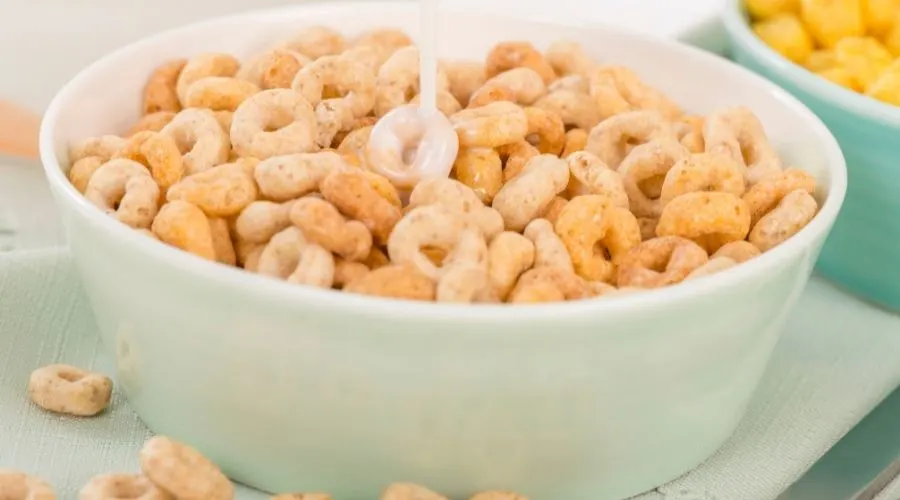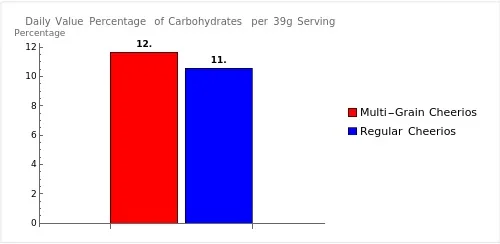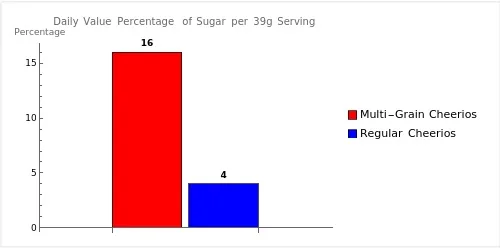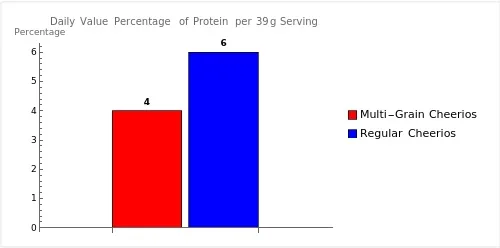When it comes to healthy choices, one of the most important decisions you have to make for you and your family is what kind of cereal will taste great while having all the benefits you’re looking for!
With so many options on the market, it can be tough to decide. But one debate that always seems to come up is whether multi grain or regular options are better.
I wanted to take a closer look at the real difference between Multi Grain Cheerios and Regular (Original) Cheerios to find out the real difference between the two and whether one is better than the other when it comes to nutrition.
Read on to see my head-to-head comparison in various nutritional categories and find out which cereal is the winner.
Also in This Article
In a hurry, or looking for something specific? Use the links below to jump to the relevant section:
- Ingredients Comparison
- Multi Grain Cheerios Vs. Regular Nutritional Comparison:
- Best for Calorie Content
- Best for Carbs & Sugar Content
- Best for Protein Content
- Best for Fat Content
- Best for Fiber Content
- Best for Sodium/Salt Content
- Best for Vitamins/Minerals
- Best for Flavor/Texture
- Best for Price
- Overall Winner
Ingredients Comparision
As you can see from the ingredients below, the main difference between Multi Grain Cheerios and the regular version is that Original Cheerios are predominantly made from whole grain oats and corn starch. In contrast, the multi grain option is made from whole grain oats and other varieties of whole grains.
Both types of cereal have added sugar, salt, and several added vitamins and minerals to help consumers reach their recommended daily values.
| Cereal Type | Ingredients | Added Vitamins & Minerals |
| Multi Grain Cheerios (General Mills) | Whole Grain Oats, Whole Grain Corn, Sugar, Corn Starch, Corn Bran, Whole Grain Rice, Whole Grain Sorghum, Whole Grain Millet, Brown Sugar Syrup, Salt, Tripotassium Phosphate, Color (caramel color and annatto extract). Vitamin E (mixed tocopherols) Added to Preserve Freshness. | Calcium Carbonate, Zinc, and Iron (mineral nutrients), A B Vitamin (niacinamide), A B Vitamin (calcium pantothenate), Vitamin C (sodium ascorbate), Vitamin B6 (pyridoxine hydrochloride), Vitamin B2 (riboflavin), Vitamin B1 (thiamin mononitrate), A B Vitamin (folic acid), Vitamin A (palmitate), Vitamin B12, Vitamin D3. |
| Original (Regular) Cheerios (General Mills) | Whole Grain Oats, Corn Starch, Sugar, Salt, Tripotassium Phosphate. Vitamin E (mixed tocopherols) Added to Preserve Freshness. | Calcium Carbonate, Iron and Zinc (mineral nutrients), Vitamin C (sodium ascorbate), A B Vitamin (niacinamide), Vitamin B6 (pyridoxine hydrochloride), Vitamin A (palmitate), Vitamin B1 (thiamin mononitrate), A B Vitamin (folic acid), Vitamin B12, Vitamin D3. |

Multi Grain Cheerios Vs. Regular Nutritional Comparison
Moving onto the nutritional comparison, and to confirm, I’ll be comparing General Mills Multi Grain Cheerios against the same brand Original Cheerios.
Both kinds of cereal have the same recommended serving size, which is 39g meaning the comparison will be weight-for-weight.
Best for Calorie Content
Starting with calorie content and of the two, the cereal with the least calories is Original Cheerios which contain 140kcal per serving, compared Multi Grain Cheerios, which contain 150kcal per serving.
| Cereal Type | Calories Per 39g Serving |
| Multi Grain Cheerios | 150kcal |
| Original (Regular) Cheerios | 140kcal |
Best for Carbohydrate Content
Although having carbohydrates isn’t necessarily a bad thing, if you’re tracking your intake, you might like to know that of the two, Original Cheerios are the lower carb option of the two with 3g less per 100g than the Multi Grain Version.
It’s important to note that neither kind of cereal is a low-carb breakfast option, which is the case for pretty much all breakfast cereals.
| Cereal Type | Carbohydrates Per 39g Serving |
| Multi Grain Cheerios | 32g |
| Original (Regular) Cheerios | 29g |

The graph maintains the same data as before, with Multi-Grain Cheerios providing approximately 12% and Regular Cheerios providing about 11% of the daily value for carbohydrates per 39g serving. The recommended daily intake of carbohydrates is 275 grams.
Best for Sugar Content
Recently I’ve been making lots of breakfast cereal comparisons for Food Compared, and the thing which has surprised me the most is the amount of sugar that some cereals contain when you don’t expect them to.
Multi Grain Cheerios is an example of this; although the name makes them sound like the healthier option, they actually contain 6g more sugar than regular (or original) Cheerios.
This difference means that Multi Grain Cheerios contain more than a teaspoon of extra sugar per serving when compared to regular Cheerios.
| Cereal Type | Sugars Per 39g Serving |
| Multi Grain Cheerios | 8g |
| Original (Regular) Cheerios | 2g |

The daily value percentages for sugar are displayed above the bars, and the graph is based on a 2,000 calorie diet. The recommended daily intake of sugar is approximately 50 grams.
Best for Protein Content
If you’re looking to increase the amount of protein in your diet, you might like to know that Original Cheerios contain 2g more protein than Multi Grain Cheerios.
| Cereal Type | Protein Per 39g Serving |
| Multi Grain Cheerios | 3g |
| Original (Regular) Cheerios | 5g |

The graph shows that Multi-Grain Cheerios provide 4% and Regular Cheerios provide 6% of the daily value for protein per 39g serving. The recommended daily intake of protein is approximately 50 grams.
Best for Fat Content
Neither kind of cereal is high in fat, although you always see some natural fat where whole grains are used.
Of the two, Original Cheerios contain 1g more fat per serving when compared to the multi grain cereal. Neither kind of cereal contains any cholesterol, and Original Cheerios contain 0.5g of saturated fat, whereas Multi grain Cheerios don’t contain any saturates.
| Cereal Type | Fat Per 39g Serving |
| Multi Grain Cheerios | 1.5g |
| Original (Regular) Cheerios | 2.5g |
Best for Fiber Content
Fiber is often an important consideration for consumers when choosing a breakfast cereal. When it comes to Cheerios, they’re classed as a ‘good source of fiber,’ but they’re not in the ‘high fiber’ category.
Of the two, the Cheerios with the highest fiber are Original Cheerios which contain 1g more dietary fiber per serving than Multi Grain Cheerios.
| Cereal Type | Dietary Fibre per 39g Serving |
| Multi Grain Cheerios | 3g |
| Original (Regular) Cheerios | 4g |
Best for Sodium/Salt Content
Both kinds of cereal have a small amount of added sodium. Of the two, the cereal with the most sodium per serving is Original Cheerios; however, the difference is nominal.
In terms of a daily value percentage, Original Cheerios contain 8% of the recommended daily sodium allowance compared to Multi Grain Cheerios, which contain 7%.
| Cereal Type | Sodium/Salt per 39g Serving |
| Multi Grain Cheerios | 150mg |
| Original (Regular) Cheerios | 190mg |
Best for Vitamins/Minerals
Original Cheerios and Multi Grain Cheerios are fortified with additional vitamins and minerals. While both are great sources of a wide range of nutrients, Multi Grain Cheerios are the clear winners of this category.
The main selling point of Multi Grain Cereals is that they contain 100% of the daily value of nine different vitamins and minerals, which is a great way to get more nutrients into your daily diet.
| Vitamin/Mineral Type | Multi Grain Cheerios Daily Value % | Original Cheerios Daily Value % |
| Vitamin D | 10% | 140% |
| Calcium | 10% | 10% |
| Iron | 100% | 70% |
| Phosphorus | 8% | 10% |
| Potassium | 4% | 6% |
| Magnesium | 6% | 15% |
| Thiamin | 100% | 20% |
| Riboflavin | 100% | – |
| Vitamin B6 | 100% | 20% |
| Vitamin C | 10% | 10% |
| Vitamin A | 10% | 10% |
| Vitamin B12 | 100% | 20% |
| Niacin | 100% | 10% |
| Folic Acid | 100% | 20% |
| Pantothenic Acid | 100% | – |
| Zinc | 100% | 20% |
Best for Flavor/Texture
In terms of flavor and texture, it isn’t easy to judge a winner because everyone prefers different things.
To get a range of opinions, we are taking a poll to see which is the public favorite.
Please submit your vote below (no personal information required), and once you vote, you’ll be able to see which is the favorite so far.
Best for Price
At the time of writing this article, a family-sized box of Multi Grain Cheerios and a family box of Original Cheerios cost the same per ounce, which you would expect with them being the same brand.
Below are the current average prices per weight; please note that these may fluctuate over time and may vary between stores and depending on offers.
- Multi Grain Cheerios 18oz box = $3.98 / 22¢ per ounce
- Original Cheerios 18oz box = $3.98 / 22¢ per ounce
Overall Winner
All categories have now been compared, and I can reveal the winner of the most categories for nutrition is Original Cheerios!
When compared to Multi Grain Cheerios, the regular version is lower in calories and sugar while being higher in protein and fiber.
Although Multi Grain Cheerios contain more vitamins and minerals, they contain 6g more sugar per serving than Original Cheerios.
So it really comes down to which you prefer and what is most important to you and your diet; hopefully, you can use the data in this article to decide which is best for you based on your needs.
| Comparison Category | Winner (Multi Grain Cheerios or Original Cheerios) |
| Best for Calorie Content | Original Cheerios |
| Best for Carbohydrate Content | Original Cheerios |
| Best for Sugar Content | Original Cheerios |
| Best for Protein Content | Original Cheerios |
| Best for Fat Content | Multi Grain Cheerios |
| Best for Fiber Content | Original Cheerios |
| Best for Sodium Content | Multi Grain Cheerios |
| Best for Vitamins/Minerals | Multi Grain Cheerios |
| Best for Price | Joint Winners |
| Overall Winner | Original Cheerios |
Related Articles
I hope this article has helped you to find the information you were looking for; you might also find the following articles helpful too:
Cheerios Vs. Raisin Bran (Which is Best?)
Special K Vs. Cheerios (Which is Best?)
Fiber One Cereal vs Oatmeal (Which One is Better)
References Used for this Article
To ensure the nutritional information used in this article is accurate, I have used data from the manufacturer; the links below contain the source information:
